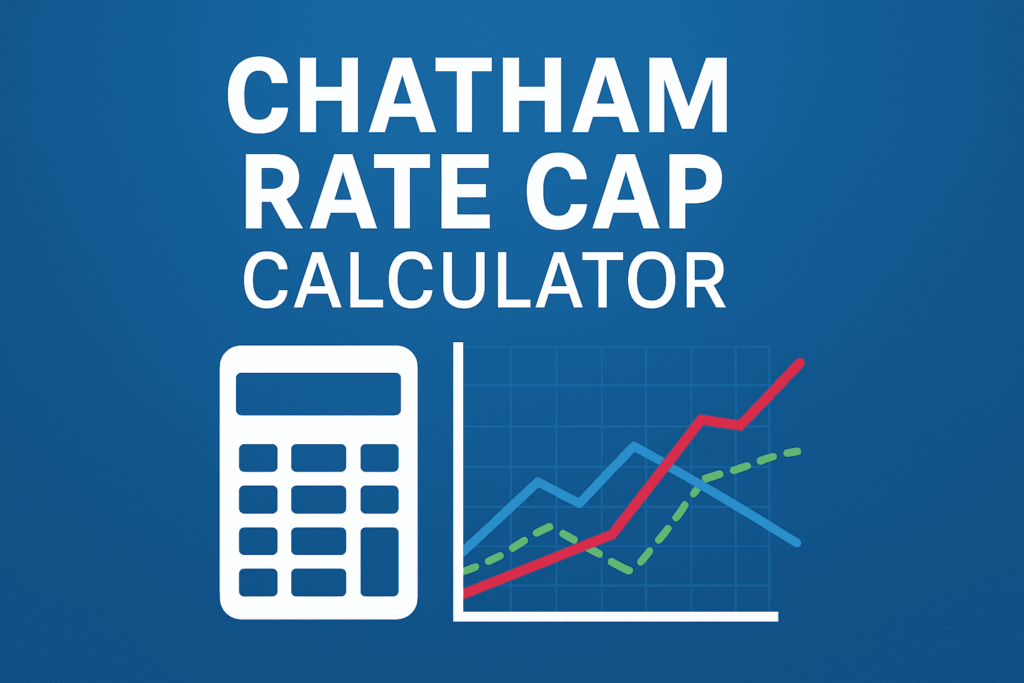Learn how to use the Chatham Rate Cap Calculator to manage interest rate risks effectively. Understand cap pricing, payouts, examples, and get free Excel/online tools.
Chatham Rate Cap Calculator
Introduction: What is a Chatham Rate Cap Calculator?
The Chatham Rate Cap Calculator is a financial tool designed for businesses, investors, and banks to calculate the cost and benefits of interest rate caps. An interest rate cap is a derivative that limits the maximum interest a borrower pays on a floating-rate loan, protecting against rising rates.
With this calculator, you can:
- Estimate cap premiums
- Calculate net interest payments
- Visualize floating rate vs cap payouts
- Make informed financial decisions
What is an Interest Rate Cap?
An interest rate cap is like insurance for borrowers with floating-rate loans. If the floating rate rises above the strike rate, the cap pays the difference.
Example:
- Notional: $10,000,000
- Strike rate: 5%
- Floating rate: 6%
The cap payout = (Floating rate – Strike rate) × Notional × Period fraction
Here, payout = (6% – 5%) × $10,000,000 × 0.25 = $25,000 (quarterly)
For related calculations and probability analysis, check out our Binomial Distribution Calculator to estimate outcomes and probabilities.

How Does the Chatham Rate Cap Calculator Work?
The calculator requires user inputs to provide detailed results:
Inputs include:
| Input | Description |
| Notional Amount ($) | The principal amount of the loan |
| Strike Rate (%) | Maximum interest rate allowed |
| Floating Rate (%) | Current floating interest rate |
| Term (Years) | Total loan period |
| Payment Frequency | Quarterly, Semi-Annually, Annually |
| Volatility (%) | Expected interest rate volatility |
Outputs include:
- Cap Premium (Estimated)
- Net Payment Table
- Floating Rate Payment vs Cap Payout Graph
- Period-wise calculation
Step-by-Step Guide to Using the Calculator
- Enter the Notional Amount – This is the principal of your loan.
- Set the Strike Rate – Maximum interest rate you want to pay.
- Provide the Floating Rate Index – Current market interest rate.
- Enter Term and Frequency – For example, 3 years with quarterly payments.
- Set Volatility – How much the floating rate is expected to fluctuate.
- Click Calculate – The table and chart display:
- Floating Rate Payment
- Cap Payout
- Net Payment
Pro Tip: Adjust strike rate and volatility to see different scenarios.
Chatham Rate Cap Pricing Explained
Cap pricing depends on:
- Notional amount
- Term
- Strike rate
- Volatility
- Payment frequency
The higher the volatility or term, the higher the cap premium.
Example Calculation
Let’s assume:
- Notional: $10,000,000
- Strike rate: 5%
- Floating rate: 4%
- Term: 3 years, Quarterly payments
- Volatility: 0.5%
Using the Chatham Rate Cap Calculator, you get:
| Period | Floating Payment ($) | Cap Payout ($) | Net Payment ($) |
| 1 | 100,000 | 0 | 100,000 |
| 2 | 102,000 | 0 | 102,000 |
| 3 | 105,000 | 5,000 | 105,000 |
Chart shows Floating vs Cap vs Net Payment over the period.
Benefits of Using a Chatham Rate Cap Calculator
- Risk Management: Protects borrowers from rising interest rates
- Easy Planning: Forecast interest payments accurately
- Decision Making: Compare different strike rates and tenors
- Visualization: Graphical comparison of floating rate vs cap payouts
FAQs
Q1: What is the difference between a cap and a floor?
A: A cap limits maximum interest, while a floor sets a minimum rate.
Q2: Can I use this calculator for all types of loans?
A: Yes, it works for floating-rate loans, swaps, and interest rate derivatives.
Q3: How is cap premium calculated?
A: It’s based on notional, strike rate, term, volatility, and frequency using Black model approximation.
Q4: Is there a free online Chatham Rate Cap Calculator?
A: Yes, you can use interactive web calculators built with HTML/JS for free.
Conclusion
The Chatham Rate Cap Calculator is essential for borrowers, investors, and financial managers to control interest rate risk. It provides clear insights into cap premiums, net payments, and expected payouts. Using the calculator ensures you make informed financial decisions with real-time data and visualizations.
Disclaimer: This calculator is for educational and informational purposes only. It does not provide professional financial advice. Always consult a licensed financial advisor before making investment or loan decisions.